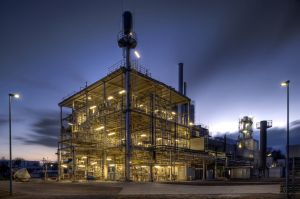Modern combustion engines become increasingly economical and clean. Engine developers, however, are now facing the technical conflict of whether fuel consumption or exhaust gas emission is to be further reduced. This Gordian knot might be cut by chemists’ and engineers’ further development of sophisticated fuels that help optimize combustion in the engine. This development work under the OME project is funded by the Federal Ministry of Food and Agriculture (BMEL) via the FNR, the central project-coordinating agency in the area of renewable resources, with EUR 800,000 for a duration of three years.
Parallel optimization of fuel consumption, exhaust gas emission, and user comfort results in a technical conflict. Stricter requirements relating to exhaust gas quality have caused engines and the exhaust gas cleaning system to become increasingly complex. “Further development of diesel and gasoline fuels now offers the chance of preventing the formation of hazardous exhaust gases directly at their origin, i.e. during combustion in the engine,” Jörg Sauer, Head of the KIT Institute of Catalysis Research and Technology, explains. “A promising concept for diesel fuels is the use of oxymethylene ethers.”
Oxymethylene ethers (OME) are synthetic compounds of carbon, oxygen, and hydrogen (CH3O(CH2O)nCH3). Due to their high oxygen concentration, pollutant formation is suppressed in the combustion stage already. As diesel fuels, they reduce the emission of carbon black and nitrogen oxides. Still, economically efficient production of OME on the technical scale represents a challenge. The OME project will therefore focus on new and efficient processes for the production of the chemical product OME.
OME might be produced from renewable resources, as is shown by the bioliq project of KIT. In this way, these substances would not only contribute to reducing pollutants, but also to decreasing carbon dioxide emission of traffic. The carbon/oxygen/hydrogen ratio of OME is very similar to that of biomass. Production with a high energy and atom efficiency is possible. “Apart from the systematic variation of reaction parameters, such as pressure, temperature and concentration, efficient methods for the processing of OME have to be developed in order to guarantee high fuel quality,” Jakob Burger of the Chair for Thermodynamics of TU Kaiserslautern explains.
Little is known about the effects of OME during engine combustion and other aspects of the use in vehicles. Comprehensive studies of engine tests will focus on these aspects of application and contribute to revealing the potentials of enhancing efficiency of OME use. These studies are to provide detailed insight into the relationships between the chemical OME structure and combustion properties. The objective is to demonstrate a highly simplified exhaust gas treatment process without particulate filters and catalytic treatment. “When using OME, fuel may be considered an active substance. This opens up a considerable potential of facilitating the trade-off between consumption and emissions and securing sustainable mobility,” Georg Wachtmeister, Head of the Institute of Internal Combustion Engines of TU München, says.
The OME project is executed by KIT as coordinator in cooperation with TU Kaiserslautern and TU München. The project with a total budget of EUR 800,000 is scheduled for a duration of three years and funded by the Fachagentur Nachwachsende Rohstoffe e.V., the central project-coordinating agency of the Federal Ministry of Food and Agriculture (BMEL) in the area of renewable resources.
More about the KIT Energy Center: http://www.energy.kit.edu
In close partnership with society, KIT develops solutions for urgent challenges – from climate change, energy transition and sustainable use of natural resources to artificial intelligence, sovereignty and an aging population. As The University in the Helmholtz Association, KIT unites scientific excellence from insight to application-driven research under one roof – and is thus in a unique position to drive this transformation. As a University of Excellence, KIT offers its more than 10,000 employees and 22,800 students outstanding opportunities to shape a sustainable and resilient future. KIT – Science for Impact.

